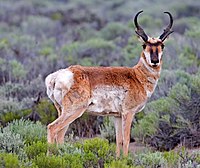
Photo from wikipedia
Learning where and when Large ungulate migrations occur across continents and inspire curiosity about how these animals know when to leave and where to go. Jesmer et al. took advantage… Click to show full abstract
Learning where and when Large ungulate migrations occur across continents and inspire curiosity about how these animals know when to leave and where to go. Jesmer et al. took advantage of regional extinctions and reintroductions of several North American ungulate species to determine the role of learning in migrations (see the Perspective by Festa-Bianchet). Reintroduced populations of bighorn sheep and moose did not migrate as historical herds had. However, after several decades, newly established herds were better able to track the emergence of vegetation in the environment and were increasingly migratory. Thus, newly introduced animals learned about their environment and shared the information through social exchange. Science, this issue p. 1023; see also p. 972 Bighorn sheep and moose learn their migration routes through culture and experience. Ungulate migrations are assumed to stem from learning and cultural transmission of information regarding seasonal distribution of forage, but this hypothesis has not been tested empirically. We compared the migratory propensities of bighorn sheep and moose translocated into novel habitats with those of historical populations that had persisted for hundreds of years. Whereas individuals from historical populations were largely migratory, translocated individuals initially were not. After multiple decades, however, translocated populations gained knowledge about surfing green waves of forage (tracking plant phenology) and increased their propensity to migrate. Our findings indicate that learning and cultural transmission are the primary mechanisms by which ungulate migrations evolve. Loss of migration will therefore expunge generations of knowledge about the locations of high-quality forage and likely suppress population abundance.
Journal Title: Science
Year Published: 2018
Link to full text (if available)
Share on Social Media: Sign Up to like & get
recommendations!